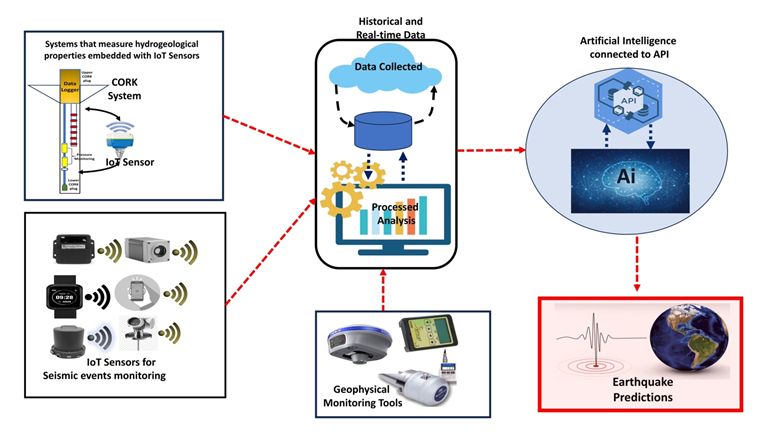From Data to Decisions: AI and IoT for Earthquake Prediction
已发布 03 四月, 2024
The study of earthquake remains a main interest worldwide as it is one of the least predictable natural disasters. In a new review published in the KeAi journal Artificial Intelligence in Geosciences, a tea, of researchers from France and Turkey explored the role of conventional tools like seismometers and GPS in understanding earthquakes and their aftermath.
“These tools have provided invaluable insights into various seismic parameters, such as ground deformation and displacement waves. However, they face several limitations, including the inability to predict earthquakes in real-time, challenges with temporal data resolution, and uneven spatial coverage,” explains Joshua Pwavodi, lead author of the review. “Despite their historical significance, these tools struggle to distinguish seismic signals from environmental noise.”
Nevertheless, the authors note that recent advancements in AI and IoT have significantly addressed some of these limitations. AI methodologies have proven instrumental in identifying intricate patterns and complex relationships within historical seismic data. By leveraging AI, unique insights into seismic patterns across diverse geological locations have been gained.
“Both classical and advanced machine learning techniques have contributed to the development of robust early warning systems and decentralized prediction models. IoT devices have also played a crucial role by enabling seamless data transmission for real-time monitoring,” adds Pwavodi.
The versatility of IoT devices enhances data accessibility and storage, creating a dynamic network for earthquake prediction. However, challenges such as computational complexity, data quality, and interpretability persist. A major limitation is the integration of primary hydrogeological measurements into AI model training. Monitoring hydrogeological data, including pore-fluid pressures and fluid flow, is often costly. Tools like the Circulation Obviation Retrofit Kits (CORKs) provide in-situ measurements of these parameters, but data transmission is not always in real-time, unlike IoT systems.
“To address these challenges, we proposed a comprehensive approach that integrates diverse datasets, including seismic, GPS, meteorological, and IoT sensor data,” says Pwavodi. “By combining these datasets, researchers can develop more robust earthquake prediction models that account for various contributing factors.”
Specifically, the authors suggest integrating IoT devices with tools like Circulation Obviation Retrofit Kits (CORKs) to enable real-time transmission of hydrogeological measurements influencing earthquakes. This real-time data, combined with other datasets, can be used to construct predictive AI models capable of providing real-time earthquake predictions.

Contact author name, affiliation, email address:
Pwavodi Joshua
Hwodye Technology, France
Social media handles:
https://www.linkedin.com/in/jtcospwa/
Conflict of interest:
The authors declare that they have no known competing financial interests or personal relationships that could have appeared to influence the work reported in this paper.
See the article:
Pwavodi, J., Ibrahim, A.U., Pwavodi, P.C., Al-Turjman, F., Mohand-Said, A., (2024). The Role of Artificial Intelligence and IoT in Prediction of Earthquakes: Review. Artificial Intelligence in Geosciences, 5(12), 100075, https://doi.org/10.1016/j.aiig.2024.100075v